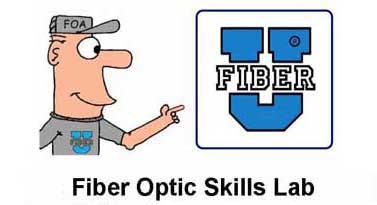Lesson
2: Fiber
Optic Tools, Test Equipment and Supplies
Objectives:
From this lesson you should learn:
Tools, test equipment and supplies will be needed to
install fiber optics
Tools needed to learn the skills necessary to install
fiber optics
Guidelines for using and caring for tools and equipment
How to use tools safely
Practice with basic fiber optic tools
Introduction
In order to learn the hands-on skills needed to install
fiber optics, you will need to acquire all the tools, test
equipment and supplies necessary for the hands-on
exercises.
Make certain before you begin that you have everything you
need - tools, test equipment and components. Download
the list of fiber optic technician's tools and
print a copy for your reference. It is a comprehensive
listing and not all may be applicable to the work you do.
Check with each lesson to see what is needed for that
lesson.
NEW:
Purchase inexpensive equipment online and use it for
hands-on lessons. Go
here.
Fiber Optic
Installers’ Tools
Learning the basic skills of fiber optics and the actual
installation of fiber optics requires having the proper
tools and knowing how to use them. These lessons will
give you directions on what tools to use and how to use
them. But first, you need to know what tools are
required and how to take care of them. Here are some of
the tools you use when working with fiber optics.
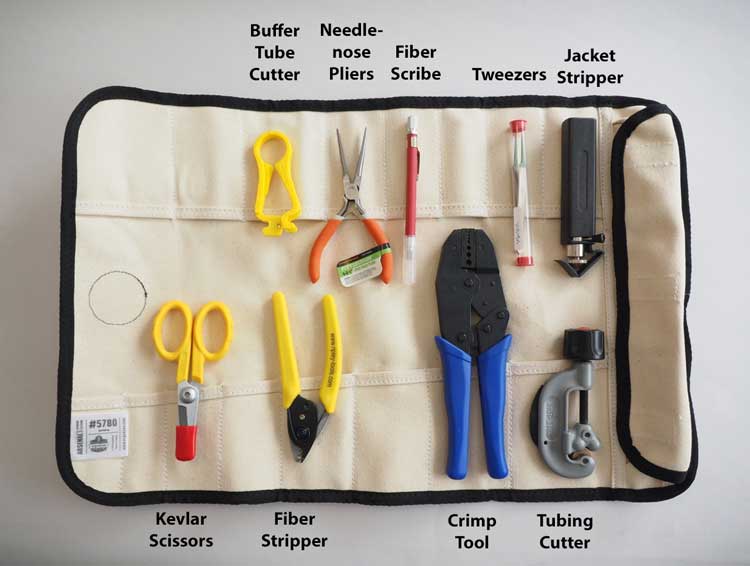
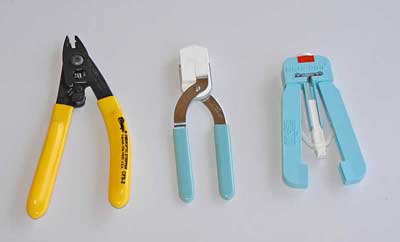
The 3 popular fiber strippers (from left): Miller,
No-Nik, Microstrip
What Tools Do You Need?
In the Basic Skills Worbook
section on Tools
used in this lesson, you will find a comprehensive list of
tools needed by the typical fiber optic technician who
will install and prep cables, splice and terminate them,
then test the installed cable plant. We also include
typical supplies for termination. We do not include heavy
equipment used for pulling cables.
You can purchase fiber optic tool kits
and/or termination kits that are prepared by manufacturers
for either generic use or to install a particular
component, usually a connector. Connector termination kits
provided by manufacturers are specific for their own
connector type and installation method. Some of these may
be replaced by the more generic tools we list below, but
some connector kits will be required for proprietary
connectors, especially prepolished-splice connector
styles.
Caution
- be wary of cheap prices on brand-name tools. We have
seen counterfeit tools being sold by distributors at low
prices which are useless.
Taking Care of Your Fiber Optic Tools
Nothing is more frustrating that
trying to accomplish something and having problems with
your tools. Whether it is not being able to find a tool or
finding a damaged tool put back in the toolbox without
being repaired or replaced. Read the section
on taking care of your tools in the Workbook
on Tools.
Setting Up A Workspace
We recommend working on a black table mat to make it
easier to see the fiber (and any scraps). It is best
to work on tile or concrete floors, not carpet. If you
drop fiber scraps into carpet they can be very hard to
find or pick up with a vacuum cleaner.

Fusion splicing workspace
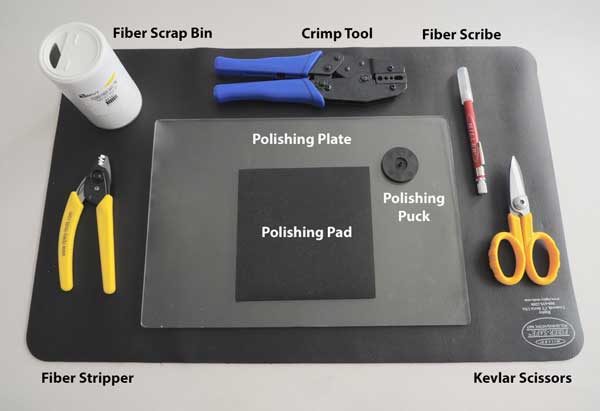
Termination with adhesive/polish connector workspace
Clean up after your exercises carefully. Some of the
scrap you generate can be harmful, such as fiber ends,
so we recommend you not work anywhere near food
preparation or children’s play areas! Place clean paper
over your work area to keep from harming the worktable
surface.
Safety
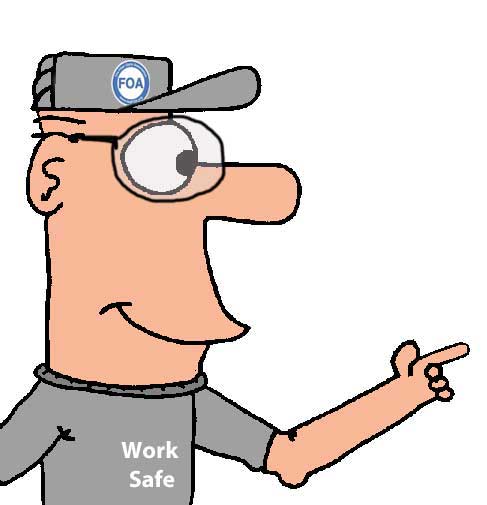 |
Please
Note: This is not the usual online course
- it is intended to guide you as you learn
new skills - the skills needed to install
optical fiber cable plants. It involves
using tools and components in a realistic
manner. Some of the processes here can be
hazardous, like working with sharp scraps
of optical fiber and chemicals. The first
lesson is about safety - we recommend
reading it carefully and posting the
safety rules for everyone to see. Always
wear safety glasses when doing any of
these exercises and dispose of all scraps
properly.
|
In Lesson 1 you
should have familiarized yourself with the safety
procedures - follow them all the time. Do not work with
fiber without safety glasses and a proper work area that
is easy to clean up. It is recommended to not work on
carpeted areas because fiber scraps can become embedded in
the carpet and be difficult to find and remove.
As
part of Lesson 1, you should have watched the FOA
YouTube Video:
FOA Lecture 2: Safety When Working With
Fiber Optics
Download
a FOA safety poster for your work area.
Assignment:
Download the Workbook section,
watch the videos and read the references
before going to the next lesson where these tools will be
used in hands-on activities..
Fiber
U Basic Skills Workbook (Download)
Tools
(PDF, 0.6MB)
List
of Fiber Optic Technicians Tools
FOA YouTube Videos
All FOA
"hands-on" videos and VHO tutorials show the use of
tools, so videos will be referenced in each process
lesson.
Online FOA References:
Fiber
Optic Tools
Book Reference:
NA
Test
Your Comprehension - Online
Quiz On Tools
Have
you completed the Workbook worksheets that are the
records of your having successfully completed the
exercises?

Get a "Certificate
of Completion" When You Complete The Course
After you complete all 6 lessons of the Fiber U Basic Skills Lab
Fiber Optics online self-study course, you can
now take an online exam and, when you pass the
exam, get a "Certificate of Completion" for this
course. You should complete all lessons
including taking the quiz ("Test Your
Comprehension") at the end of every lesson. When
you think you are prepared, you can take an
online exam for a nominal fee ($20) which will
give you a "Certificate of Completion" for
this course.
Take the Test to Get Your
Certificate of Completion For This
Course
- Next: Lesson
3: Fiber Optic Cables
-
Return
to Lesson Plan
|
